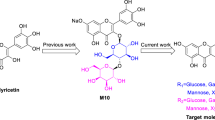Abstract
In order to investigate the relationship of the structure and hypoglycemic activity, rhein amide derivatives 2a–2e were synthesized and their hypoglycemic activities were evaluated by glucose consumption in HepG2. Their structures were characterized by 1H-, 13C NMR, IR, mass and elemental analysis. All the compounds exhibited strong hypoglycemic activity in improving glucose consumption in HepG2 cell assays in vitro, which was influenced by the diversity of rhein amide derivatives. The compounds 2a–c, 2f, and 2g bearing heterocyclic ring were proved to be more potentially useful in glucose consumption than dimethyldiguanide. Among all the compounds, compound 2f exhibited the strongest activity on glucose consumption, while compound 2d showed the weakest activity.


Similar content being viewed by others
References
Anabela PR, Carlos MP (2006) Diabetes and mitochondrial function: role of hyperglycemia and oxidative stress. Toxicol Appl Pharmacol 212:167–178
Baxter AD, Walmsley A (2005) Ester derivatives of rhein and their therapeutic use, pp 1–12. US7728035
Benson VS, VanLeeuwen JA, Taylor J, Somers GS, McKinney PA, Van Til L (2010) Type 1 diabetes mellitus and components in drinking water and diet: a population-based, case–control study in Prince Edward Island, Canada. J Am Coll Nutr 29:612–624
Bettag MK, Richardson A, Rettenberger R, Heger PW (2008) Long-term toxicity studies in dogs support the safety of the special extract ERr 731 from the roots of Rheum rhaponticum. Food Chem Toxicol 46:1608–1618
Brownlee M (2001) Biochemistry and molecular cell biology of diabetic complications. Nature 414:813–820
Chao JD, Nau DP, Aikens JE (2007) Patient-reported perceptions of side effects of antihyperglycemic medication and adherence to medication regimens in persons with diabetes mellitus. Clin Ther 29:177–180
Hnatyszyn O, Mino J, Ferraro G, Acevedo C (2002) The hypoglycemic effect of Phyllanthus sellowianus fractions in streptozotocin-induced diabetic mice. Phytomedicine 9:556–559
Jan-Willem D, Ralph JFM, Fred H, Coen DS, Stephan FEP, Luc JCL (2011) Postprandial hyperglycemia is highly prevalent throughout the day in type 2 diabetes patients. Diabetes Res Clin Pract 93:31–37
Kalyoncu U, Gossec L, Nguyen M, Berdah L, Mazieres B, Lequesne M, Dougados M (2009) Self-reported prevalence of psoriasis and evaluation of the impact on the natural history of hip osteoarthritis: results of a 10 years follow-up study of 507 patients (ECHODIAH study). Jt Bone Spine 76:389–393
King H, Aubert RE, Herman WH (1998) Global burden of diabetes, 1995–2025: prevalence, numerical estimates, and projections. Diabetes Care 21:1414–1431
McEwen LN, Kim C, Haan MN, Ghosh D, Lantz PM, Thompson TJ, Herman WH (2009) Are health-related quality-of-life and self-rated health associated with mortality? Insights from Translating Research into Action for Diabetes (TRIAD). Prim Care Diabetes 3:37–42
Mu YM, Jin MM, Chi C, Lu JM, Pan CY (2008) Therapeutic effects of rhein on the insulin resistance in liver of diabetic rats induced by streptozotocin. Diabetes 57:717
Owton WM, Brunar SM, Miles MV, Dobson DR, Steggles D (1995) Synthesis of 4,5,8-trimethoxy-9,10-dioxo-9,10-dihydroanthracene-2-carboxylic acid, an analogue of rhein with improved systemic exposure in the guinea pig. J Chem Soc Perkin Trans 7:931–934
Pietrangelo A, Travagli V (2005) Esters of hyaluronic acid with rhein, process for their preparation and compositions comprising the same, pp 1–12. US7834173
Xu JS, Ma MW, Purcell WM (2003) Characterisation of some cytotoxic endpoints using rat liver and HepG2 spheroids as in vitro models and their application in hepatotoxicity studies. I. Glucose metabolism and enzyme release as cytotoxic markers. Toxicol Appl Pharmacol 189:100–111
Zhu XK, Ye XL, Yuan LJ, Ding YP, Zhang BS, Li XG (2012) Synthesis and hypoglycemic activity evaluation of 7-alkoxyl-rhein. Med Chem Res 21:421–427
Acknowledgments
This work was supported by Scientific Research Foundation for PhD of Southwest University (SWU111064, 111072), the Fundamental Research Funds for the Central Universities (XDJK 2011C050), and Chongqing Engineering Technology Research Center of Veterinary Drug (CSTC, 2009CB1010).
Author information
Authors and Affiliations
Corresponding author
Rights and permissions
About this article
Cite this article
Zhu, X., Ye, X., Song, L. et al. Synthesis and hypoglycemic activity evaluation of rhein amide derivatives. Med Chem Res 22, 2228–2234 (2013). https://doi.org/10.1007/s00044-012-0215-7
Received:
Accepted:
Published:
Issue Date:
DOI: https://doi.org/10.1007/s00044-012-0215-7




